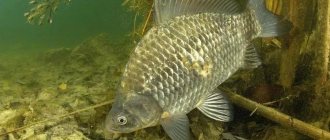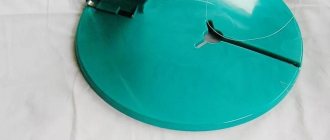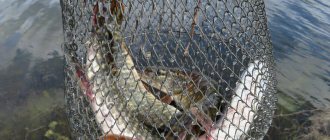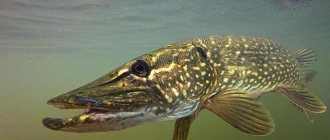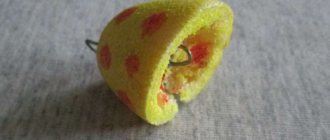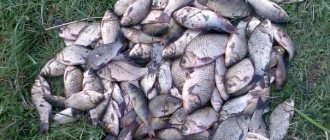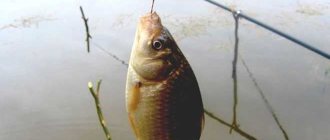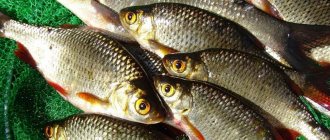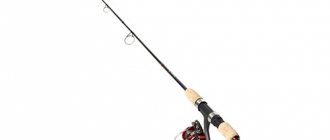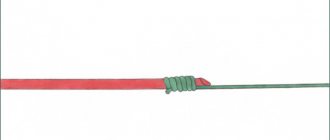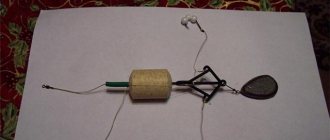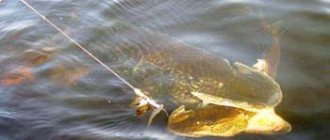Fly fishing
- this is the most natural type of fishing among those existing throughout the world; it organically fits into its rightful place in the series of natural processes. The fly fisherman is closely confronted with the phenomena occurring in the water. Therefore, he, willy-nilly, is drawn into these processes, takes part in them, learns to live in unity with nature. In his work, he relies on a phenomenon that, in various forms, is widespread in the world around us since the time of its creation - illusion. He uses what science calls “mimicry”, his flies imitate the fish’s usual prey and behavior. His knowledge of the laws of nature, his ability to create illusion is the secret of his success.
History of fly fishing
History of fly fishing Fly fishing is one of the oldest methods of fishing. There is a mention of it in the texts of the peoples of the Mediterranean, dating back to the first - second centuries AD. But fishing with an artificial fly reached its heyday only in the 19th century. It was most popular in England. It was included in the list of mandatory skills that a true gentleman should have. Of course, this fishing method was common among the nobility. But it is worth noting that it was not in England that fly fishing reached its true scale. Scotland, largely due to the abundance of salmon, is considered the birthplace of sport fly fishing. This is, one might say, a national sport. In the first half of the 19th century, fly
began to become a hobby in Russia. Largely due to European fashion trends. But she never gained much popularity. Currently, we can observe a new stage in the development of this fascinating fishing method.
Why fly fishing?
Why fly fishing? Every year the number of people passionate about fishing is growing. Wild, very remote places are becoming more accessible. More and more people can afford the use of helicopters, expensive high-speed boats, etc.
But the number of fish with such rapid development of scientific and technological progress is decreasing. Fly fishing has become a kind of compromise, a type of fishing in which the number of fish caught ultimately fades into the background. With the advent of experience and professionalism, anglers who are passionate about fly fishing in most cases switch to catch-and-release fishing.
In addition, the presence of fly fishers on water bodies has a positive effect on the condition of these water bodies. There is a long-forgotten word “enthusiasm”, which was so popular in Soviet times. It was on enthusiasm that fly fishing in our country survived at one time. And only because for people who picked up a fly fishing rod, this hobby became the passion of their whole life.
Fly fishing
Fly fishing
- lively, mobile, sometimes very prey. Why is it not widespread? There are many reasons for this. If for worm fishing with a float rod you can use any rods and fishing lines, then for fly fishing the choice of gear must obey particularly strict requirements. Not every rod is suitable for fly fishing, and the line must have some special qualities. Then, many people do not like or cannot walk for hours. Fly fishing requires dexterity, caution, and the ability to hide from the eyes of fish walking near the surface of the water. And no other method is surrounded by such prejudices as fly fishing. Let's list the most important ones: fly fishing can only be done in fast waters; Fly fishing can only be fished with flies, grasshoppers and dragonflies; Fly fishing can only be done in July and August; fly fishing only catches small things; It is good for them to fish only by wading, etc. Next we will determine the exact price of these opinions, but for now we will point out the features of fly fishing.
When going for this fishing, take a light folding rod and a folding hook. In your pocket, put a small reel of line and a wallet, the size of a cigarette case, with leaders and flies. Now you are ready. Don’t dig for worms, don’t steam oats, don’t catch live bait, don’t have the hassle of storing them, don’t take care of places, don’t carry heavy weights, and even if it’s heavy from the fish you catch, then this heavyness is only pleasant. You can fish from the shore, from a boat, from a bridge, or by wading. From the lake you can go to the waterfall, from there to the pond to the herbs, from the pond to the river, and all this with the same fishing rod and without any modifications to the gear.
You can (and even should) not adhere to fishing patterns. The more creative you are, the heavier your bag of fish will be.
Gear device
The first steps for beginners to get acquainted with fly fishing will be to understand how the tackle itself works and what it consists of.
Rod, reel, backing, line, connector, leader, bait - this is fly fishing.
Rod
The fly fishing rod has guides and is equipped with an inertial reel. Rods can be one-handed or two-handed. Rods are divided into classes according to their action; there are currently 21 of them. The larger the class, the stronger the rod. The rods are quite light, similar to spinning blanks, and are made of light and durable material. At first they produced synthetic fishing rods made of fiberglass, but now carbon fiber has replaced other materials. There is an extra class - laminated bamboo, these are handmade rods.
Coil
The reel must be selected taking into account the fishing conditions and the class of the rod. On more powerful forms, a higher power coil is accordingly installed.
Backing
The first lessons are an introduction to the concepts used in this type of fishing and not always familiar to beginners. Such as, for example, “backing”.
In order to lengthen the working surface of the working cord, an additional synthetic cord, called backing, is tied to it. This is necessary to catch large fish.
Also, when using inertia-free reels, the low level of the cord in relation to the side of the spool significantly affects the operation of the tackle and here backing helps out.
The amount of backing winding is determined experimentally. The length of the backing is chosen so that when winding the cord, there is about 1-2 mm left to the side of the spool. If the cord level is higher, 4-5mm, then the line flow will worsen when casting.
Rewinding the backing is done as follows: very carefully (without twisting) we wind the cord onto the spare spool, tie the backing to it and wind it exactly on the main spool in the reverse order. The backing is attached to the cord with a reliable knot, such as a needle knot. As you reel in the backing, hold it with your finger to ensure even distribution throughout the spool.
There is a way to connect the cord and backing without loops. It is necessary to sew the cord with backing, then the connection will be smooth and of the same thickness. To do this, 4-5 mm of plastic is removed from the cord. Then this bare piece of cord is impregnated with PVC glue and 5 mm is impregnated with the same glue. backing. Using a needle, make these sections flat and fold them together. Then sew them with thread, securing them with loops. Coat the resulting connection with PVC glue again. Dry.
Cord and backing
Cord
There is a marking on one end of the cord. This is where you need to start winding the reel. Any twisting of the cord is not permitted. If it is twisted, the cord will become unusable. The cord should not be wound flush with the edge of the spool because when fishing when playing, you will not be able to perfectly rewind the cord; it may go beyond the edges of the spool (You took this into account when measuring the backing - 1-2 mm. You didn’t wind it up).
The cord should exit in front of the connecting post of the reel towards the first ring.
Connector
A connector is a braided or other attribute that allows you to quickly disconnect the cord from the undergrowth. Another type of connection is rings. These rings have a seamless and smooth shape. Used, for example, when connecting a fluorocarbon leader and a nylon leader.
Undergrowth
Undergrowth is an important part of the rig. With its help, there is a smooth transition from the cord to the front sight. You can buy leader or make your own from fluorocarbon fishing line. The length depends on the fishing conditions, casting and so on. Usually 2.2-2.4 meters.
For beginners, those who are just learning the basics, the length of the leader with a leash should not exceed the length of the rod without a handle. This will make it more convenient to use the gear. For aces, the length of the undergrowth with a leash will depend on the fishing conditions - depth, bait (dry or nymphs). Experienced fly fishermen usually select the length of the leader experimentally.
Leash
Hanging flies are tied to the leash. The first hanging leader should have the same diameter as the end of the leader (if the leader is conical). The second hanging leash should be of a larger diameter. To prevent leashes from getting tangled, they are made of different lengths. The first one is shorter – 50-70 centimeters; the second is longer -100 centimeters. In order to better distinguish the leashes and untangle the flies faster, use fishing line of different colors.
Dry flies
The very first gear does not have to be expensive. Until you master the casting technique, there is no point in spending money. The pricing policy for gear is very diverse. Expensive forms, as in spinning rods, cost 500 - 1000 dollars. Budget options for fishing rods cost about 3,000 Russian rubles. This also applies to the rest of the equipment.
Fly Fishing Equipment
Components of fly fishing gear
1) rod; 2) coil; 3) cord; 4) backing; 5) loop on backing; 6) loop on the cord; 7) bandage; connecting the cord to the leash using a bandage; 9) option of connecting the cord to the leash using a knot; 10) leash; 11) connection leash undergrowth; 12) undergrowth; 13) front sight mount; 14) front sight. A typical set of fly fishing gear includes a rod, fishing line (cord), inertial reel, backing, leaders and leaders, and artificial flies.
Rod
The main component of the tackle for fly fishing is the rod, to which the reel and line are selected. Modern technologies make it possible to make fishing rods from carbon fiber. They are very good and precise in their work and do not require special care. With such equipment you can safely join the art of fishing.
The length of fly fishing rods is measured in feet (1 foot = 30.5 cm). Short rods up to 7 feet long are calibrated to cast light line sizes 3-4. They can be recommended to those who like to fish in mountain streams, where the cast must be short and precise. Longer rods are designed for fishing in rivers where long casting is required. When fishing tight spots or shallows, short rods are preferred, but if you are using a wet (sinking) fly or nymph, then 8-9 foot rods are better. By taking our advice into account and testing different models, each angler will choose the most suitable rod for himself, allowing him to cast as best as possible. When purchasing a fishing rod that always shows the manufacturer's recommended fly line number, find out how it operates, whether it is fast or parabolic. The advantage of a fast rod is the ease of casting over short distances, but a parabolic rod develops such power when the line accelerates that casts become very long.
Coil
The main purpose of a fly fishing reel is to store the line and balance the tackle, and also, in some cases, to land large fish.
Most modern good reels often have a wide spool with a large diameter. This design allows for better placement of the cord so that when unwinding from the reel, it will not initially resemble a spring.
The design of the brake is not very important when fishing for small fish, but when fishing for salmon, for example, you need to have a disc brake of some kind. In addition to the disc brake, the design of the reel should make it possible to brake the spool with the palm of your hand.
We should not forget about the so-called backing or extension cord, which is a thin braided nylon cord, from 50 to 100 meters of which is wound on a reel under the main fly fishing cord. This is your reserve when biting large fish, which can easily “remove” the entire fly line and part of the backing from the reel. In addition, reeling from backing allows the fly line to lie on the reel in rings of not too small diameter, that is, less deformation.
Fly lines
Unlike spinning fishing, where the spinner pulls the line due to its weight, fly fishing has a light fly. Consequently, a heavy and thick cord is used for casting, flying due to its own gravity. In order to impart the required flight speed, it accelerates by swinging the spinning rod above its head.
Cords are classified according to weight, degree of buoyancy, geometric shape, and also according to their purpose.
According to the degree of buoyancy, they are distinguished:
- A floating line
is used for surface fishing or small drowning in the water column, where the depth is formed only by the weight of the fly. - An intermediate line
is characterized by a gradual movement towards the bottom. The use of this variety is associated with the need to immerse the fly to the required depth, when the weight of the bait alone is not enough. - A sinking line (sinking line, full sinking line)
goes completely to the bottom, so it is used when fishing at great depths. - A combined floating line with a slightly sinking or completely sinking end (sinktip line, floating/intermediate line)
has found its application when fishing at various depths in accordance with the sinking speed of the sinking part. In this case, control of the wiring of the floating part of the cord in the current is simplified.
Backing
Backing
– a twisted thin cord made of synthetic fibers, used to lengthen the length of the tackle when catching large fish, and also helps to increase the diameter of the winding in order to position the cord on the reel closer to the edge of the spool.
Running
Running
– additional part – extension of the fly fishing cord. It has a sliding coating that makes it easier for the shooting head to move through the rod's guides. Without a running back, shooting heads are never used. Parts of the equipment are usually connected using the “loop-to-loop” method.
Fly fishing flies
Flies for fly fishing Perhaps the most specific tackle in fly fishing, as in spinning, is the bait.
Currently, an artificial fly is a kind of fishing art. Many passionate professionals have long mastered its production, and, moreover, have achieved considerable success in this matter. It has been noticed that hand-made flies are much more effective; they are strictly oriented, for example, to fly fishing for grayling or chub. In order to understand a little about fishing techniques, you need to have a good understanding of the classification of flies. After all, the selection of gear and the choice of casting method directly depends on what kind of fly you will be fishing with. The classification of flies is quite complex, but there is no need to go into it too deeply at first. The main thing is to remember the main groups of baits and understand their fundamental differences. Types of artificial flies:
- Dry wingless
. These baits imitate a subimago or adult. They mainly imitate all types of insects that live on the surface of the water. - Dry winged
. They also imitate subimagos and adults, but on these baits the wings, legs, body, and bristles are clearly visible. They should float perfectly and dry quickly. - Wet flies
. These are precisely the baits that are used to fish the water column, and not its surface. These are mainly nymphs (imitation of various larvae). - Streamers
. Perhaps the most complex flies, which should imitate the behavior and appearance of fry. - Nymphs
. They create imitation of invertebrates (worms, larvae, amphipods) that live in water. - Fantasy flies
. Independent products create provocations in the fish environment, acting aggressively in their habitat. - Emergers
are copies of insect larvae that float to the surface of the water and imitate the transformation into a large insect.
Undergrowth
Between the end of the line and the fly there should be a piece of relatively thin fishing line that does not scare away the fish and allows you to properly work with the bait, ensuring its natural behavior in the water. The undergrowth can be tied from pieces of fishing line of different diameters, with the larger diameter being attached to the end of the cord. However, most modern leaders, braided or regular, already have a conical shape with a gradually decreasing diameter from the tip of the line to the fly. In this case, it is appropriate to use a small, 40-60 cm long piece of ordinary fishing line, the so-called leash, tying it to the end of the undergrowth. This allows you to maintain the working length of the leader while frequently replacing flies - after all, every time you re-tie the bait, several centimeters of fishing line are lost, so it’s better to use a “buffer” leash rather than expensive leader.
Fly fishing lures
The main lures for fly fishing are artificial flies. This type of bait in its appearance resembles an insect or beetle, which are collected by fish on the surface and in the water column. Flies can be different in size and weight, being determined, like hooks, by a certain numbering. The higher the number, the more massive and heavier the front sight. In addition, flies are divided into two types: dry and wet.
Important! Dry ones are used for fishing from the surface, and wet ones in the water column.
Experienced fly fishermen tie their own flies, preparing the bait for specific fishing conditions and fishing styles.
Fly fishing technique
Fly fishing technique Fly fishing
is effective during the period of time when fish rise en masse to the surface of the water. For example, in the summer, when it actively feeds on insects, or in the first days of the spring thaw, when only the upper layers of water warm up. When fly fishing, good camouflage is required, for example, khaki clothing. It’s good to fish in a wade this way, especially with a small wave or fast current.
An important condition for successful fishing is the ability to cast a fishing rod correctly. It is necessary to smoothly place the fly on the water, and it should come into contact with the water before the reins and fishing line. Casting accuracy is no less important. Good skills can only be mastered through systematic training. First, the exercises are performed on a special platform with obstacles, and then they are moved to the water.
There are two options for fishing: with a dry fly and with a wet one, as well as bottom fishing with a nymph. In the first case, the casting location is chosen based on the splashes of the fish, the casting itself is carried out from the knee, and the bite is assessed by eye. In the second case, the fly is allowed to sink completely into the pond, after which it must be constantly pushed, because the fish actively bites only on a moving bait.
There are two main casting techniques used: regular and power.
Normal cast
consists of three stages: back swing, cord extension and forward swing. The success of the entire throw depends on the first stage, the importance of which many recklessly underestimate. The swing must be done quite strongly, using the rod you need to lift the line and throw it back. Initially, only the forearm is involved in the lifting; the hand joins only in the last stages. You need to finish it strictly with the rod in a vertical position. Now you need to stop and wait until the cord is completely straightened, after which you extend the cord and swing forward in the same way. The rod should move in a straight line. It should be stopped in the clockwise position at 4 hours 30 minutes.
The cord is lengthened before the forward swing begins. To do this, before you start casting, you need to grab the cord directly next to the reel with two fingers of your left hand and unwind a small amount of it and place it between your hand and the drum and hold it in this position while making a backswing. When the cord is almost completely straightened, the section held by your fingers should be released.
To improve your casting technique, it is recommended to perform the following exercise. First, blank casts are performed. A back swing is made, then a forward swing, after which, without allowing the fly to come into contact with the water, you should again proceed to the back swing. Idle casts continue until the height of the forward swing reaches head level. Then you should move on to extending the cord. During the back swing, which is carried out with the right hand, two fingers of the left hand need to grab the cord near the drum and release a small section of it from the spool. At the moment of complete straightening of the cord before the forward swing, the section of it grasped by the fingers of the left hand must be released, and the remaining part must be fixed again to the rod with the freed left hand. You need to make several casts with extension until the fly touches either the ground on the back swing or the water on the forward swing.
Power cast
used to achieve maximum range. In this case, additional acceleration can be given to the cord by lengthening the line in the manner described above, both when swinging forward and when swinging backward.
If there is not enough space behind for a full backswing, use side or ring casts. The first one is practically no different from a regular overhead cast. The only peculiarity is that the fishing rod moves in a horizontal plane. To make a ring cast, the fishing rod is slowly raised to the clockwise position at 2 o'clock, after which a forward swing is performed. In this case, a ring rolling forward should form on the cord.
Casting with a two-handed rod is done in almost the same way as with a one-handed one. The only peculiarity is that it is impossible to extend the line with your left hand; it must always be located on the butt of the rod. The free loop of the cord for extension is placed on the segment between the right hand and the reel. You need to release the cord just before it straightens when swinging forward. The casting rhythm when using a two-handed rod is slower compared to a one-handed one.
Fly fishing tackle for beginners. How to make the right choice
- Fly fishing gear components ⇩
- Rod ⇩
- Coil ⇩
- Cord ⇩
- Leader or leash ⇩
- Installation of fly fishing gear ⇩
- Fishing technique ⇩
- Front sight selection ⇩
- Fly fishing knots ⇩
- How to avoid mistakes as a beginner fly fisherman ⇩
- Prices ⇩
Fly fishing occurs in the upper layers of water without a float or sinker. This fishing method simulates the free fall of bait into the water. This is a complex and fascinating type of fishing, which is gaining more and more supporters in our time.
Fly fishing gear components
Rod
One of the most important components is the fishing rod. There are fourteen classes of such rods for fly fishing. The first and second classes correspond to the lightest gear. At the same time, catching fish with their help requires great skill.
Light rods are not intended for beginners. Rods of classes eight to fourteen are designed for catching large fish. The fifth, sixth and seventh classes of rods are well suited for those who are just starting to master this method of fishing.
They can consist of two or four elbows; in the first case, they are more reliable; four-piece models provide greater convenience for fishing. You can choose a fishing rod from any material, the main thing is that it is not overly flexible. It is best to choose a cork handle. It is more convenient.
Coil
The next component of such gear that we will consider is the reel. There are three main types.
- Automatic.
- Multiplier.
- Ordinary.
When choosing, you need to make sure that the reel does not weigh more than the rod. It would be wise to choose a regular type of coil. Moreover, it must be equipped with a brake that will not allow the cord to unwind after a powerful jerk.
The reel drum must be designed for a cord length of thirty to sixty meters. It is optimal to use a cord of such length that when wound it does not rub against the edges of the reel.
Cord
Just like the rod, the line is the most expensive part of the fly fishing tackle. If you actively engage in fly fishing, then most likely the line will have to be changed at least twice during the season. Its thickness must be selected in accordance with the class of the fishing rod.
If the fishing rod corresponds to the sixth or seventh class, then the cord should be chosen of the same class. They come in different colors. The most convenient one is the one that is difficult to see in the water. Therefore, using a white cord is more convenient. After fishing in dirty water, you should clean the line so that it is still invisible to the fish.
Leader or leash
When fly fishing, a leader is used that is made from a fishing line whose diameter gradually decreases. The most convenient option is for its diameter to decrease from 0.5 to 0.2 millimeters along its length.
In this case, the thick end is attached to the cord, and the fly is attached to the thin end. The total length of the leash is usually 2.6 meters. If the rod is shorter than this value, then the leash needs to be shortened by at least half a meter. After each cast, the leash must be checked for knots. If they form, then it is best to change the undergrowth, since its strength from the knot sharply decreases.
Installation of fly fishing gear
When assembled, such gear has the following appearance.
The numbers indicate the types of nodes that are used to connect the components. The most common type of knot for attaching cord or backing to a reel is the arbor knot.
As you can see from the figure here, this knot is quite simple. In this case, another knot is additionally tied at the end of the cord or backing in order to increase the strength of the connection.
Next you need to tie the cord to the backing. For this purpose, the use of a special albright knot is provided.
Tie it like this:
- Fold the cord in half and hold the loop with two fingers.
- Thread 30 centimeters of backing inside the loop.
- Wrap the backing around the folded cord and thread it back through the loop.
- Tighten the knot.
Next, the cord needs to be tied to the undergrowth. A nail knot is usually used for this.
Nowadays, in most cases, there are special loops on the cord and on the pendant for a loop-to-loop connection. If they are not there, then you can use this node.
How to connect it is clear from the drawings.
Here, a small tube is used as an auxiliary tool, which is then removed.
Next you need to attach the leader to the leash. For this, a double surgeon's knot is used. It is very simple and at the same time very reliable.
To increase the strength of the last knot, it needs to be wetted before being completely tightened.
Now to finish installing the fly fishing gear, all that remains is to attach the fly to the leader. There is also a special node for this purpose. It's called improved clinch knot. It is also quite simple and yet reliable.
It is recommended to wet it before finally tightening it.
Fishing technique
Successful fly fishing requires great skill. You need to make the fish believe that the fly you are throwing is a tasty bait that the fish cannot resist. To do this, you need not only to understand well what exactly needs to be done, but also to train long and hard in order to achieve success.
At the first stage, it makes sense to spend your time observing the life of the reservoir where you are going to fish. You need to take a closer look at what kind of fish behaves and what exactly it prefers to eat.
Next, in accordance with your considerations, you need to select exactly the fly that will give the highest chance of getting results.
When fishing, try to have different types of flies that you might like on that body of water. It is advisable to prepare at least two specimens for each species in case the bait is lost.
Trout can grab the bait and then swim away unnoticed. Therefore, it is important to be alert at all times and keep your tension tight, constantly watching it so as not to miss the fish.
In some cases, simulating a bite when fishing with a nymph can help. If the fish swims up, you need to pull the bait 15 centimeters. This may attract these fish.
In some cases, trout can be provoked into chasing your bait. If the fish gets carried away, it may swallow the hook before you even hook it.
Front sight selection
Sometimes a fisherman believes that choosing a particularly effective fly will provide an almost complete chance of success in fly fishing. Experienced fishermen rather believe that this gives no more than a twenty percent chance of success. Eighty percent of success comes from good fly technique.
Fly fishing knots
To attach various elements of fly fishing gear, it is customary to use certain nodes, which were described above. They have proven their effectiveness in practice, which has led to their widespread use.
How to avoid mistakes as a beginner fly fisherman
It must be remembered that movement and play of the fly are very important. In particular, it must correspond to the flow of water.
When choosing a fish with which to begin your improvement, it is recommended to pay attention to the bleak. Catching it is much easier than for other types of fish.
An important point for achieving success in fly fishing is the correct execution of fishing. First the fish needs to be tired. Then you need to move it, making sure that the tackle does not sag or get tangled.
Prices
A high-quality fly fishing rod is not a cheap thing.
SAGE One will cost 47,450 rubles, ORVIS Helios 2 will cost 36,000 rubles.
RIO Traut LT fly fishing line sells for 2,000 rubles. RIO Redfish will cost 4290 rubles.
RIO Dacron Fly Line Backing will cost 650 rubles.
Fly fishing is an exciting activity that requires great skill and dexterity. In order to achieve success in this field, you need not only high-quality equipment, but also knowledge combined with experience and constant improvement.
Rating: 5 1 votes
Fly Fishing Accessories
Fly fishing accessories In addition to the basic gear, you need to take care of other accessories that you cannot do without in fly fishing.
Since the fisherman has to wade into shallow water, he will need a pair of regular fishing boots that cover the entire thigh. Those who fish in deeper waters will need waders (wading overalls) that reach to the armpits and allow them to reach the best fishing spots. Another important piece of equipment is a fishing vest. Various small items are stored in its pockets, and a special knife is hung from it on an elastic cord so that, if necessary, you can easily cut fishing line. In addition, you should get a bottle of silicone and a pin to remove excess silicone from the eye of the hook. It is difficult to do without a landing net, which opens automatically when necessary, which can be easily removed, and also folded and put away in a case. The pockets of the vest should contain transparent plastic boxes for storing bottles of silicone, flies (fly boxes), and tubes of gels. Finally, glasses with polarizing lenses are also very useful: you will not be blinded by glare on the water and you will be able to see fish rising to the surface or exploring the bottom in search of larvae.
Fly fishing tools
Fishermen - “fly fishermen” are very often fond of tying fly fishing flies. This is determined by the desire not only to save money on buying bait, but rather to create a new catchy fly with your own hands. At first glance, it seems that fly tying is a complicated process, but this is just an illusion. Making a fly is actually very simple. True, this will require special fly fishing hooks and tools. The most expensive device is a vise. They are used to clamp hooks. As a rule, this tool is in the form of a collet clamp equipped with a screw or lever drive. When tying flies, various materials are used, including feathers. In order to fix them and then hold them around the hook, special clamps are used. They are made from steel wire with a diameter of 3 mm. In addition to these tools, you will need scissors and forceps. Perhaps this is the entire set necessary to create a new beautiful catchy fly with your own hands.
